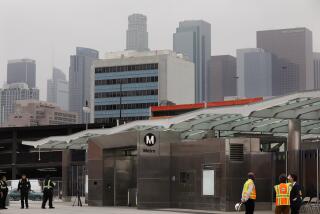Monorail Cheaper Than Metro Rail
- Share via
Monorail has been proven over time.
The first system was installed in Wuppertal, Germany, in 1901 and is still in operation. Japan’s first monorail, between Tokyo and the Haneda Airport, was installed in 1964, continues in operation and is profitable. The new Disney World monorail, in peak seasons, carries upwards of 200,000 passengers per day (more than the Baltimore, Buffalo and Miami rail systems combined).
New monorail switching is not cumbersome or unsightly. The new monorail switches now used in Japan can perform lock-to-lock in nine seconds.
In addition to being aesthetically pleasing, monorail is inherently quiet. At Disney World, monorail travels directly through the fifth floor of the hotel where guests sleep directly above and dine directly below, 20 hours a day.
Instead of wasting over $300 million per mile on subway tunnels, we could build a monorail system at an estimated $40 million to $60 million per mile--a fraction of the cost of Metro Rail--along the already acquired rights of way of our freeways.
Most importantly, monorail is inexpensive to maintain and operate. Traditionally, rail systems recover only about 5% of their costs from fares. Will we be able to afford the hundreds of millions of dollars it is going to cost us to keep these systems running?
The updated Los Angeles County Transportation Commission/Gruen Valley Monorail Study shows that monorail construction can take place at night with little disruption to freeway traffic, and it recommends monorail as the best choice for the Valley. A recent UCLA study recommended monorail as the best system to connect LAX to the Palmdale airport.
A free brochure on monorail is available at P.O. Box 2157, Van Nuys, CA 91404.
WILLIAM J. KOREK
Van Nuys
Korek is co-chairman of the Citizens Committee for Monorail and a past member of the county transportation commission .
More to Read
Sign up for Essential California
The most important California stories and recommendations in your inbox every morning.
You may occasionally receive promotional content from the Los Angeles Times.













